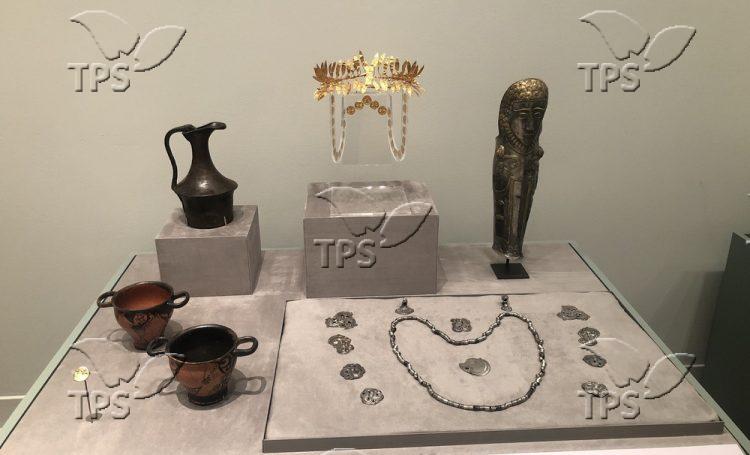The Treasure of Malomirovo-Zlatinitsa: A Rare Victory for Archaeologists in the Unrelenting Race against Treasure-Hunters
Jerusalem, 24 July, 2023 (TPS-IL) -- SOFIA, 24.07.2023 (BTA)
Eighteen years ago yesterday, on July 23, 2005 an untouched Thracian tomb was discovered in what was called “the Grand Mound” between the villages Malomirovo and Zlatinitsa in Southeastern Bulgaria. For several years already Daniela Agre, one of the leading Bulgarian experts in the areas of Thracian burial and settlement archaeology, had been raising funds to explore the site – in an unrelenting race against treasure-hunters that had turned the Grand Mound into an anthill.
In a country so rich in ancient findings like Bulgaria, archaeologists rarely win this competition. When the first opening into an underground cavity was cleared, the comments of the workers were “A badger’s lair!”. In this case, luck and perseverance contributed generously to produce one of the most impressive archaeological findings of recent years.
Unlike most of the known ancient Thracian tombs with their elaborated masonry, niches, vaulted brickwork, etc., the Malomirovo-Zlatinitsa tomb was merely a hole in the ground – a shaft with wooden walls and wooden floor. But what it held immediately identified it as a burial site of a Thracian ruler. He lived around the middle of the IV century BC and died at the age of 18-20. Here, for the first time, archaeologists found untouched the full panoply of war: an iron sword makhaira (a blade with a forward curve), two quivers with a total of 200 arrows, spears, chainmail, bronze helmet, and horse ammunition. One of the most impressive artefacts found was a greave covered with rich images and scenes from Thracian mythology.
Ancient Thracians had no literacy of their own, which hinders the study of their culture and defining their own profile amongst the existing cultures in the region, for the Thracians actively interacted with the peoples surrounding them: Greeks, Persians, Scythians, and Celts. For that reason, practically every unearthed artefact adds new knowledge about the rituals, practices, and way of life, economy, architecture, habits and beliefs of ancient Thracians. Artefacts speak about the past with the language of images and craft.
On the silver greave found next to the ruler’s head, gold was used to shape human curly hair, producing the effect of a blonde woman and a blonde warrior. The greave was not just a protective piece for the lower part of the leg: it was a sign of the social status, an object to tell stories. The greave found in Malomirovo-Zlatinitsa site shows a female face with a luxurious hairstyle and ornaments. Below the female head, the surface is conditionally divided into two symmetrical parts, on which four different scenes are presented, with real and fantastic characters. The ready parallel is the Achilles’s shield in The Iliad: an ornate work of art, a weapon and an indication of rank; as much a decoration as a piece of armor.
There was only one greave placed in the tomb – intended for the left leg; a single greave was part of funeral offerings found at the Mogilanska Mogila in Vratsa.
The content of the grave clearly shows that a king, a prince or aristocrat was buried here. The head of the deceased was decorated with a magnificent golden crown, and on the little finger of his left hand was a solid golden ring. There was also an abundance of burial gifts, among them rhytons and phials.
The extraordinary luck in finding such a treasure intact combined with the unusually high level of preservation. For instance, not only the makhaira sword, but also the wooden scabbard is preserved. A unique find is a pair of leather shoes that the deceased was buried with (a detail that tempted the journalists to use more than once the expression “moccasined lord”). Even the remains of the ritually sacrificed animals offered a surprise: one of the horses carried in its haunch a calcified arrowhead (showing that the piece had remained there for a long time).
The high level of conservation might be due to the fact that an unusual amount of salt was found around the body. It might be that the man had died elsewhere; a long distance from the site, and salt has been used to slow down the process of putrefaction. Such an explanation goes well with the well-preserved fragments of leather and textile.
Few of these details impress us as much as the golden wreath with the image of Nike, the goddess of victory. It is truly the emblem of the Malomirovo-Zlatinitsa treasure and few artefacts of that time could compete in elegance and delicacy with these thin laurel leaves made by of beaten gold. And under the wreath, on a hemp band hung 29 golden rosettes so that the reconstructed image reminds us more of a crown or a tiara.


